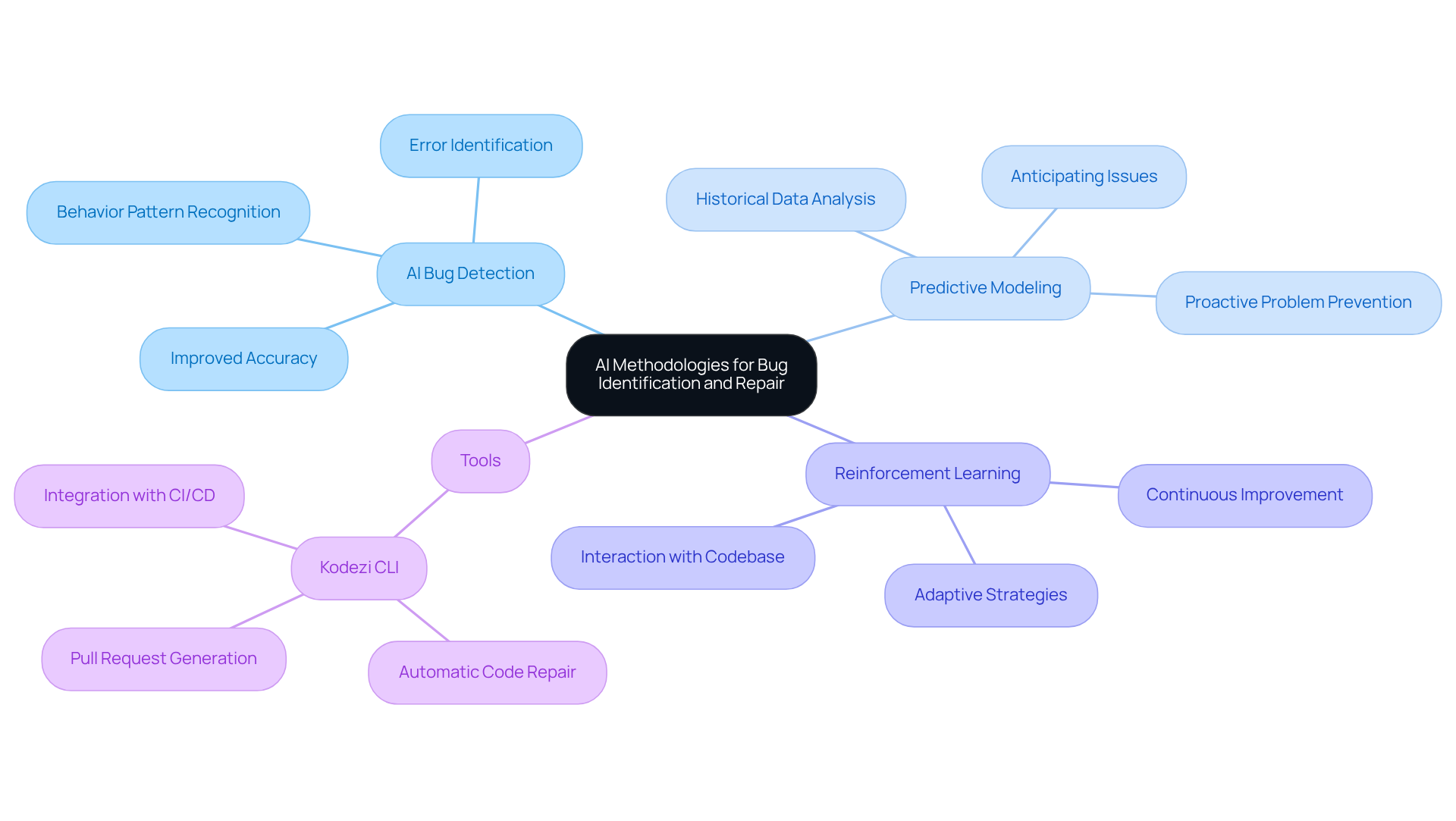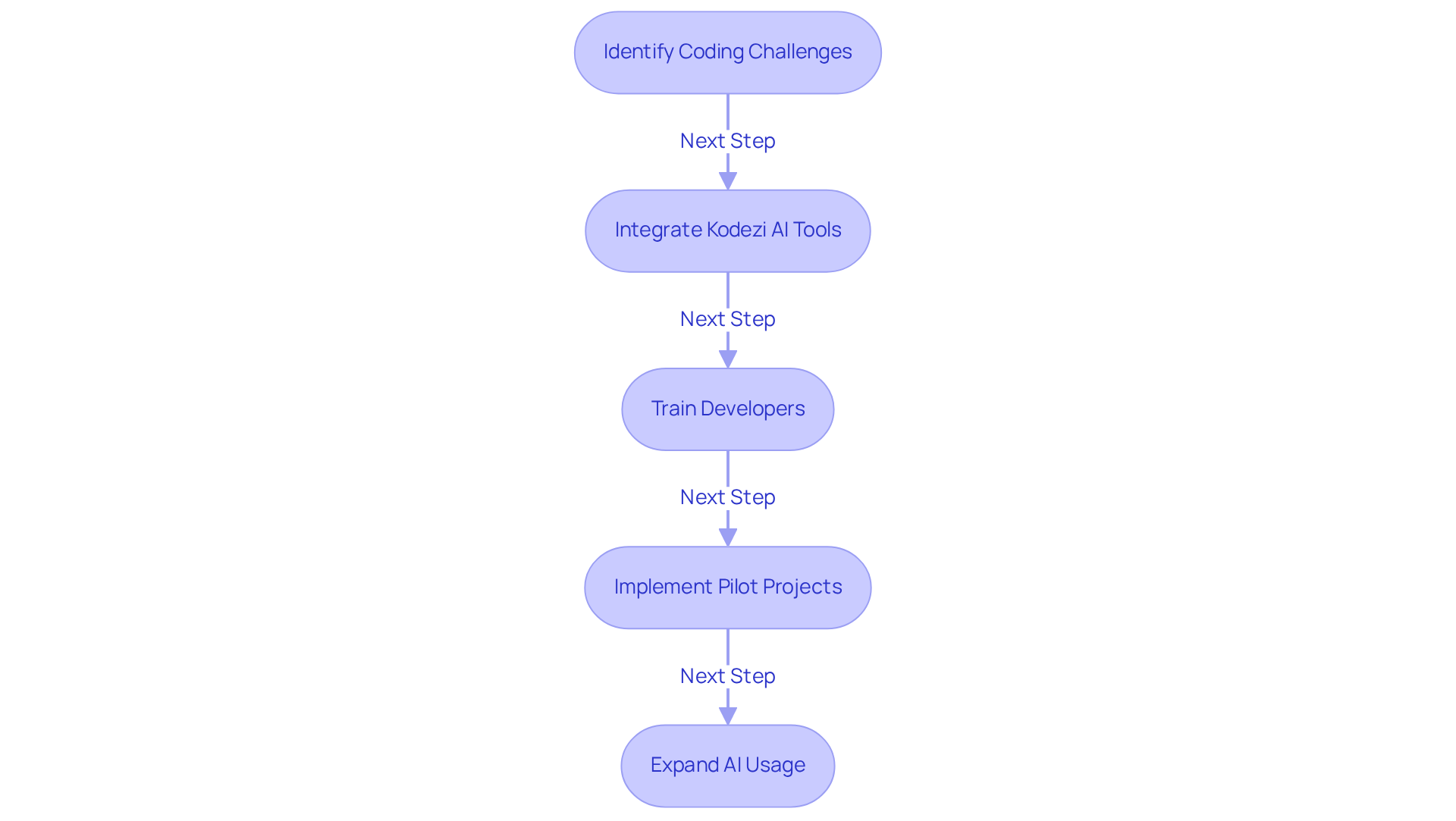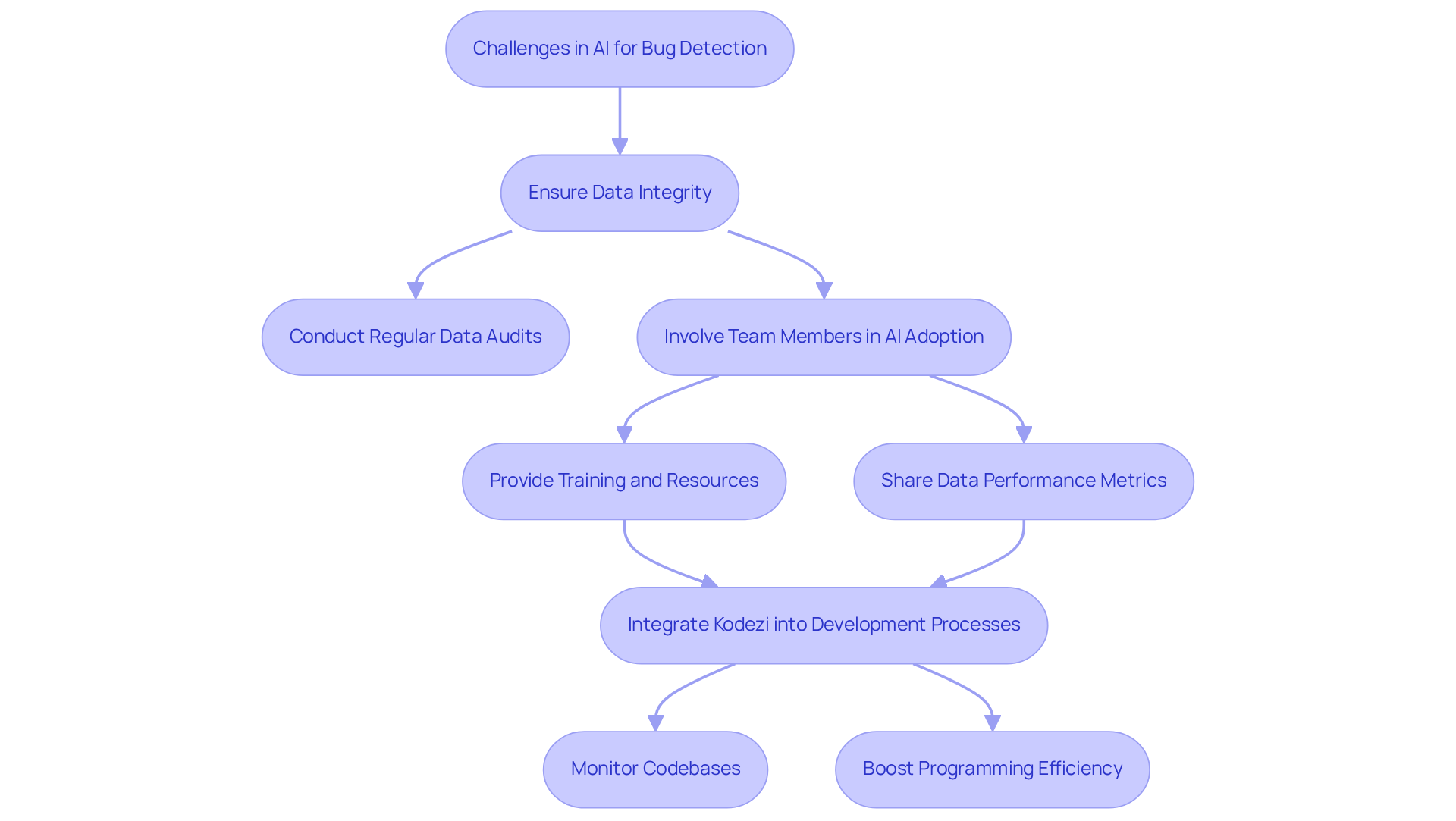Overview
Developers often encounter significant coding challenges that can hinder their efficiency. AI bug detection and fixing addresses these issues effectively by utilizing machine learning algorithms to identify and resolve problems in real-time. This proactive approach not only improves efficiency but also enhances accuracy in software development. Furthermore, methodologies such as predictive modeling and reinforcement learning empower developers to tackle bugs before they escalate, leading to better defect detection rates and quicker turnaround times.
By integrating AI into the development process, teams can experience substantial improvements in productivity and code quality. Imagine being able to catch errors before they become costly issues—this is the promise of AI-driven tools. In addition, the ability to resolve problems swiftly allows developers to focus on innovation rather than getting bogged down by recurring bugs.
Are you ready to elevate your coding practices? Explore the powerful tools available on platforms like Kodezi, which leverage AI to streamline your workflow. With these advancements, developers can not only enhance their coding efficiency but also ensure a higher standard of code quality. Don't miss the opportunity to transform your development experience.
Introduction
The landscape of software development is marked by significant challenges, particularly in the areas of bug detection and fixing. As developers navigate these complexities, artificial intelligence emerges as a transformative solution. With advanced AI methodologies at their disposal, developers can streamline the debugging process, enhancing both code quality and reliability. However, the integration of these powerful tools is not without its hurdles; organizations often face issues related to data integrity and team adaptability.
How can teams effectively leverage AI's capabilities to address these challenges and achieve optimal software performance?
Understand the Role of AI in Bug Detection
Developers often grapple with the complexities of coding, particularly regarding AI bug detection and fixing bugs and vulnerabilities in their software. AI is revolutionizing this aspect of software development through AI bug detection and fixing, offering a solution that enhances efficiency and accuracy. By leveraging machine learning algorithms, the process of AI bug detection and fixing can swiftly analyze extensive codebases in real-time, pinpointing potential issues that might elude human developers. For instance, AI-driven tools utilize both static analysis—examining scripts without execution—and dynamic analysis, which observes scripts during runtime. This comprehensive dual approach significantly minimizes the time required for manual debugging, which enhances AI bug detection and fixing, leading to a more efficient development process.
Furthermore, AI systems continuously learn from historical data, which enhances their AI bug detection and fixing capabilities while adapting to evolving coding patterns and practices. This flexibility is essential, as it enables teams to uphold high software quality while accelerating release cycles. In fact, organizations that have implemented AI bug detection and fixing into their QA processes report a 32% increase in test scenario coverage and a 50% improvement in defect detection rates for startups. As a result, teams can achieve not only faster turnaround times but also a marked enhancement in overall productivity. Are you ready to explore the tools available on platforms like Kodezi that can transform your development practices?

Explore AI Methodologies for Bug Identification and Repair
Developers often face significant challenges in coding, especially regarding AI bug detection and fixing. AI methodologies play a crucial role in addressing these issues, with AI bug detection and fixing emerging as a leading approach. This method enables AI systems to recognize typical behavior patterns within programming, allowing them to identify deviations as potential errors. Furthermore, predictive modeling enhances this process by utilizing historical data to anticipate where issues are likely to arise, based on previous trends. In addition, reinforcement learning allows AI agents to refine their bug detection and repair strategies through continuous interaction with the codebase.
By combining these methodologies, development teams can create a robust framework for maintaining software quality, which includes proactive AI bug detection and fixing. Kodezi CLI exemplifies this approach by independently enhancing codebases and resolving issues before they reach production. This functionality acts as a flexible resource for teams, enabling them to automatically repair their code. For instance, Kodezi CLI can automatically recommend solutions for identified issues, offering detailed explanations and insights into what went wrong and how it was resolved. This capability simplifies the debugging process and alleviates the workload on developers.
Consider this: "AI reduces debugging time by helping developers quickly trace the origin of a bug." This statement underscores the efficiency gained through these methodologies. This proactive approach not only enhances efficiency but also contributes to higher software reliability, as tools focused on AI bug detection and fixing, like Kodezi CLI, significantly reduce debugging time and improve bug detection accuracy. Why not explore the tools available on the Kodezi platform and see how they can transform your coding practices?

Integrate AI Tools into Development Workflows for Enhanced Efficiency
Coding challenges can be daunting for developers, often leading to delays and frustration. However, Kodezi offers a powerful solution to these issues by seamlessly integrating tools for AI bug detection and fixing into development workflows. With Kodezi CLI, engineering teams can enhance software quality and resolve bugs before they reach production. Key features include:
- Automated program evaluations
- Continuous integration (CI) pipelines
- Real-time monitoring systems
For instance, incorporating Kodezi's AI-powered programming analysis tools within the CI/CD pipeline significantly improves AI bug detection and fixing, thereby reducing the costs and efforts associated with resolving problems later in the development process.
Have you ever wondered how your debugging process could be transformed? User testimonials reveal that Kodezi has revolutionized debugging for over 1,000,000 users, boosting productivity and making the debugging process feel like a superpower. To maximize the benefits of these tools, it is essential to equip developers with the necessary training in AI bug detection and fixing, fostering a collaborative environment that merges human expertise with AI capabilities. By adopting a phased integration strategy—starting with pilot projects and gradually expanding AI usage—teams can minimize disruptions while maximizing the advantages of AI-enhanced workflows.
This approach not only streamlines processes but also aligns with the growing trend where 76% of developers anticipate that AI tools will be more integrated into writing code over the next year. Explore the tools available on the Kodezi platform and discover how they can elevate your coding experience.

Address Challenges in Implementing AI for Bug Detection
Coding challenges are a common struggle for developers, particularly when it comes to bug detection. The use of AI bug detection and fixing introduces various difficulties, especially concerning data reliability and a reluctance to change among team members. Statistics indicate that 57% of companies are experimenting with AI in assurance; however, many face issues related to insufficient data standards, which can lead to ineffective AI models. To overcome these obstacles, teams must prioritize data integrity by ensuring that training datasets are comprehensive and representative of real-world situations. Regular data audits can help uphold high standards and proactively address potential issues.
Fostering a culture of openness and collaboration is essential in reducing resistance to AI integration. By involving team members in the AI adoption process, organizations not only enhance buy-in but also cultivate a shared sense of ownership. Providing training and resources for developers to upskill in AI technologies is vital; this empowers them to effectively manage AI tools and grasp their benefits. As industry specialists suggest, transparency in sharing data performance metrics can further strengthen organizational commitment to data improvement initiatives.
Furthermore, tools like Kodezi can significantly aid in addressing data integrity issues. Kodezi independently monitors codebases, identifying and resolving issues as they arise, which is crucial for maintaining high data standards necessary for effective AI implementation. Its features in automatic error analysis and correction enable teams to boost their programming efficiency and ensure software standards are upheld before production.
To maximize the effectiveness of Kodezi, teams should integrate it into their development processes, leveraging its features to continuously assess and enhance programming standards. By proactively tackling these challenges and securing leadership support for data improvement initiatives, organizations can create an environment conducive to successful AI adoption. This strategic approach not only enhances capabilities for AI bug detection and fixing but also positions organizations to fully leverage AI's potential in their software development processes.

Conclusion
The integration of AI in bug detection and fixing signifies a transformative shift in software development, addressing the coding challenges developers frequently encounter. By harnessing advanced methodologies and tools, such as Kodezi, developers can significantly reduce the time spent on manual debugging, ensuring a higher quality of code and a more streamlined development process.
How does Kodezi tackle these challenges? The platform employs AI methodologies, including predictive modeling and reinforcement learning, which empower developers to proactively identify and resolve issues within their codebases. This automation not only enhances the debugging process but also fosters collaboration and continuous learning among team members, ultimately creating a more productive and effective development environment.
Embracing AI in bug detection is not merely a trend; it is essential for organizations striving to remain competitive in the rapidly evolving tech landscape. By prioritizing data integrity, fostering a culture of collaboration, and integrating AI tools into existing workflows, teams can overcome implementation challenges and unlock the full potential of AI. This strategic approach not only enhances software quality but also paves the way for innovation and growth in the future of software development.
Frequently Asked Questions
What is the role of AI in bug detection?
AI plays a significant role in bug detection by enhancing the efficiency and accuracy of identifying and fixing bugs and vulnerabilities in software. It utilizes machine learning algorithms to analyze extensive codebases in real-time, helping to pinpoint potential issues that might be missed by human developers.
What are the two main types of analysis used in AI bug detection?
The two main types of analysis used in AI bug detection are static analysis, which examines scripts without execution, and dynamic analysis, which observes scripts during runtime. This dual approach helps minimize the time required for manual debugging.
How does AI improve the bug detection process for developers?
AI improves the bug detection process by continuously learning from historical data, which enhances its capabilities and allows it to adapt to evolving coding patterns and practices. This results in higher software quality and accelerated release cycles.
What improvements have organizations reported after implementing AI bug detection?
Organizations that have implemented AI bug detection into their QA processes report a 32% increase in test scenario coverage and a 50% improvement in defect detection rates, leading to faster turnaround times and enhanced overall productivity.
What tools are available for developers looking to implement AI bug detection?
Tools available for developers include platforms like Kodezi, which offer AI-driven solutions to transform development practices and improve bug detection and fixing processes.




